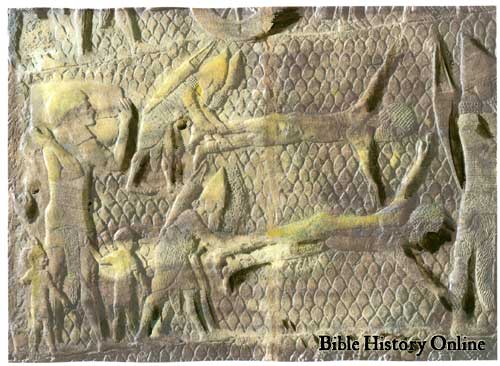
Could these be Hebrews that the Assyrians were skinning alive?
Lachish Captives
Being Skinned Alive

Could these be Hebrews that
the Assyrians were skinning alive?
This alabaster wall panel was part of a series of panels that decorated the walls of the mighty king Sennacherib of Assyria, who's capital was Nineveh.
It shows the Assyrian soldiers brutally abusing the captives of the conquered city of Lachish in 701 BC. The prisoners are being skinned alive. Lachish was a strongly fortified city located about 25 miles SE of Jerusalem. The amazing discovery of this panel is important in the study of Biblical Archaeology because it reveals the horrifying cruelty of the Assyrians and the brutal treatment of their prisoners. The Assyrians were raised up by God to punish Israel for their rebellion against Him. Never in history were a people so brutal. Their awesome warfare tactics are still studied today.
"Now it came to pass in the fourteenth year of King Hezekiah that Sennacherib king of Assyria came up against all the fortified cities of Judah and took them." - Isaiah 36:1-2
Material - Alabaster Panel
Neo Assyrian
Date: 700 BC
Height: 197.85 cm (77.8937008 inches)
Width: 45.08 cm (17.7480315 inches)
Depth:
Nineveh, northern Iraq
Excavated by: Henry Layard 1845-1849
Location: British Museum, London
British Museum Excerpt
Stone panel from the South-West
Palace of Sennacherib (Room 36, no. 10)
Nineveh, northern Iraq
Neo-Assyrian, about 700-681 BC
The siege and capture of the city of Lachish in 701 BC.
This alabaster panel was part of a series which decorated the walls
of a room in the palace of King Sennacherib (reigned 704-681 BC).
The story continues from the previous panel (no. 9) of the relief.
This section decorated a corner of the room.
Having been exiled from their city, the people of Lachish move
through the countryside to be resettled elsewhere in the Assyrian
Empire. Below them high officials and foreigners are being tortured
and executed. It is likely that they are being flayed alive. The
foreigners are possibly officers from Nubia. The Nubians were seen
as sharing responsibility for the rebellion. Much of Egypt at this
time was ruled by a line of kings from Nubia (the Twenty-fifth
Dynasty) who were keen to interfere in the politics of the Levant,
to contain the threat of Assyrian expansion. As Sennacherib's forces
laid siege to Lachish, an Egyptian army appeared, led by a man
called Taharqa, according to the Old Testament. He may be the later
pharaoh of Egypt with the same name (690-664 BC). Sennacherib's
account claims that the rebels had called on the support of the
kings of Egypt (Delta princes) and the Kings of Kush (Nubia). The
armies clashed on the plain of Eltekeh. While Sennacherib claimed
victory, he was still not able to capture Jerusalem.
The story continues on the next panel (no. 11) of the relief.
Length: 269.24 cm
Width: 180.34 cm
Length: 256.54 cm
Width: 101.6 cm
ANE 124909
Room 10, Khorsabad Palace reliefs & Assyrian sculpture
The British Museum
Related Pages:
Lachish in Easton's Bible Dictionary
Biblical Archaeology: Assyria
Archaeology of Ancient Assyria - Archaeological Discoveries
Ancient
Near East - Images and Art
Free Bible - Fallen Empires (Biblical Archaeology)
Bible History Links - Ancient Near East : Art & Images
Free Bible - Ancient Art
Assyria and Bible Prophecy - Timeline of Events
Ancient History Timeline
The Destruction of Israel - Kings of Israel, Judah and Assyria
Archaeology of Ancient Assyria - Khorsabad
Timeline 800 - 700 BC
The Assyrians
The Captivity
Archaeology of Ancient Assyria - Calah
Ancient Babylonia - Nimrud
Archaeology of Ancient Assyria - Austen Henry Layard
Archaeology of Ancient Assyria - Ancient Assyria
International Standard Bible Encyclopedia - Calah
Ancient Sketches